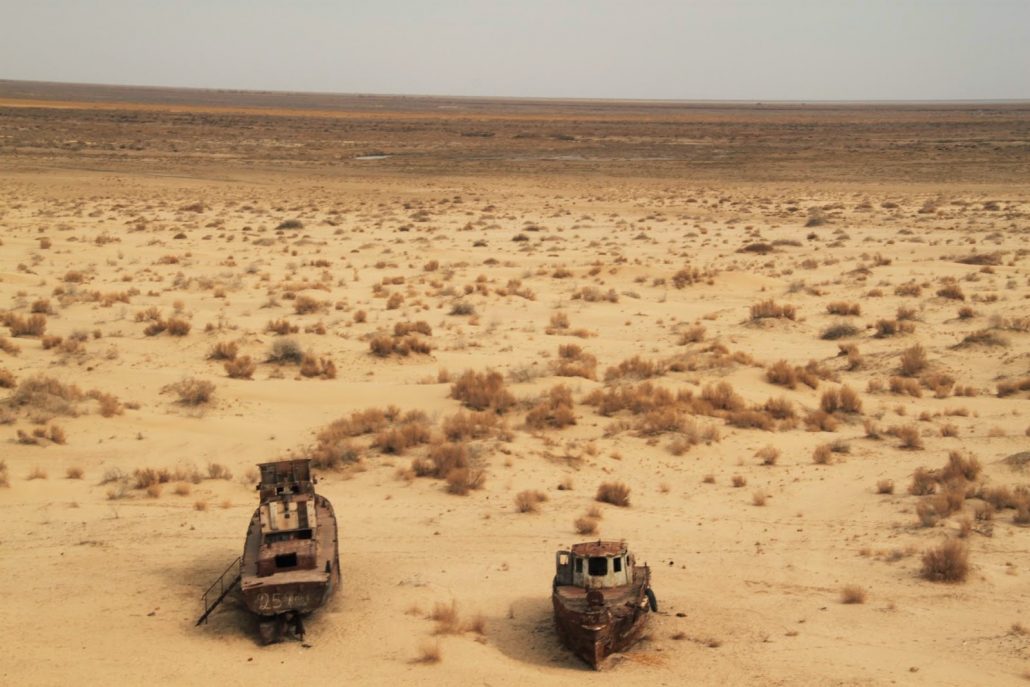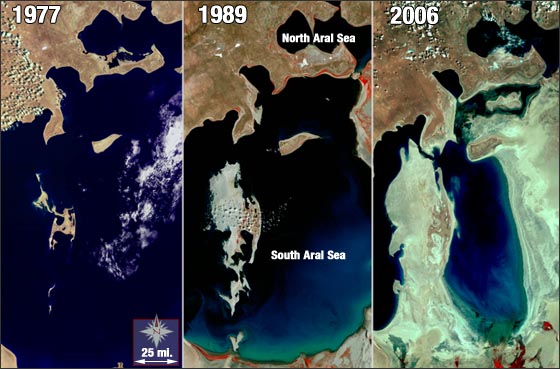 If there is an example of how humans are altering ecosystems in their lifetime, consider the Aral Sea in Central Asia.
If there is an example of how humans are altering ecosystems in their lifetime, consider the Aral Sea in Central Asia.
Once considered the fourth largest lake in the world, it has shrunk to a mere 10% of its original size over the past sixty years.
The lake bed has turned into a desert. Earlier this month, violent salt storms damaged crops, affected livestock farms, and caused respiratory problems in people living in the region. Where is the Aral Sea and what led to the current situation?
The Decline Of The Aral Sea
The Aral Sea is located in Central Asia between Kazhakstan and Uzbekistan, both previously part of the Soviet Union.
The Syr Darya river to the north and the Amu Darya river to the south once drained into the Aral Sea. This meant that water that was evaporating from the lake was being replaced by the rivers.
 But all that changed in the 1960s. The Soviet Union started diverting water from the two rivers to irrigate cotton farms in Kazakhstan, Uzbekistan, and Turkmenistan. As less water from the rivers started reaching the Aral Sea, the lake started shrinking. And in just two decades (by the 1980s), the rivers dried up and did not reach the sea.
But all that changed in the 1960s. The Soviet Union started diverting water from the two rivers to irrigate cotton farms in Kazakhstan, Uzbekistan, and Turkmenistan. As less water from the rivers started reaching the Aral Sea, the lake started shrinking. And in just two decades (by the 1980s), the rivers dried up and did not reach the sea.
Thus, began the decline of the Aral Sea. By the end of the 20th century, the Aral Sea had broken up into three regions with two lakes in the south and a small lake in the north and had shrunk to just one-fourth of its original volume.
The Impact
As the Aral Sea started shrinking (due to evaporation), the salt content of the water started increasing. This caused the once-thriving fish population to die out. In addition, pesticides and herbicides from Soviet Union agricultural practices polluted the waters.
Communities that once sat on the shore of the Aral Sea, such as the town of Moynaq, saw their economies crash as the fishing industry and their livelihood was lost. At its peak, the Aral Sea provided 98% of Uzbekistan’s fish supply.
Not only did these communities suffer a loss of jobs, food, and water sources, they began experiencing respiratory illnesses kidney diseases, and cancer. The salt and pesticides left in the dried seabed of the Aral Sea were being blown into their towns. The climate in the region had changed as well. Without adequate precipitation, the summers are getting hotter and winters colder.
What Can Be Done?

Now, the community of Moynaq has begun planting saxaul trees in the dry seabed of the Aral Sea. These trees are able to create healthy soil around their roots and prevent the wind from picking up contaminated soil and spreading it to the towns.
Half a million hectares, almost a million football fields worth, of trees have been planted and the community plans to continue until all 3 million hectares of seabed have been covered. Although it will take 150 years to grow a forest, these trees are a long-term solution to correct issues surrounding the dried Aral seabed.
The decline of the Aral Sea is an example of the environmental and economic repercussions of irresponsible irrigation and water management. The Aral Sea is often referenced now when decisions are made surrounding water diversion, as it shows how entire ecosystems and countries can be affected by water diversion.
Sources: BBC, Columbia, NASA.gov







